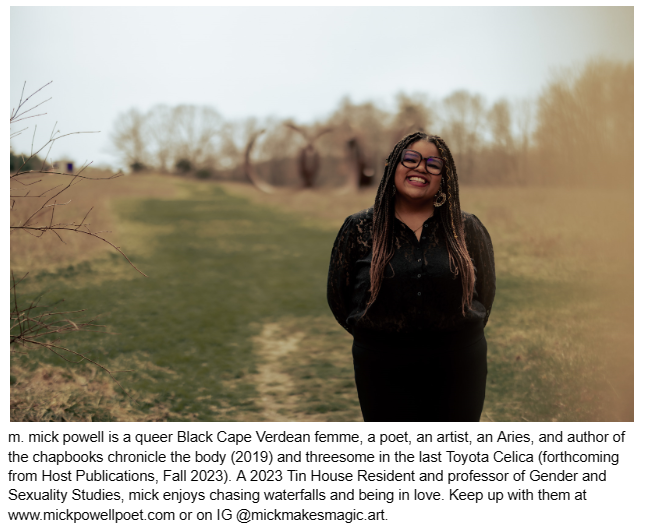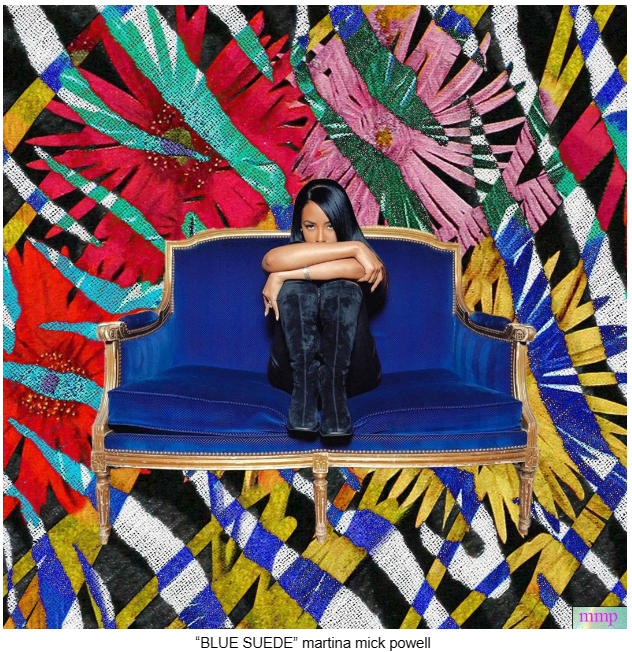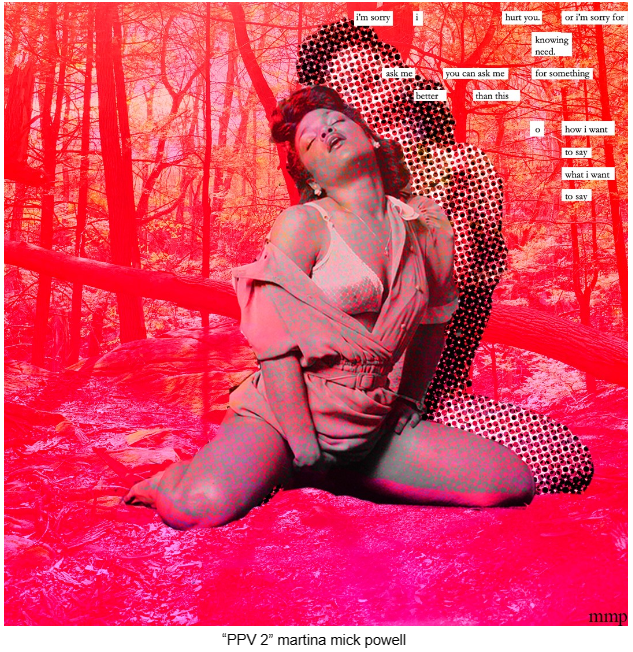|
It was coincidental to learn two different approaches to ERASURE projects by two African American creators, Gary Simmons and m. mick powell on the same weekend.
Gary Simmons currently has an exhibition at the Museum of Contemporary Art Chicago until October 1st, 2023. Simmons' erasure is a smudging effect on race, class, and gender identity issues. The smearing techniques draw attention to historical problems and discrimination more vividly. My guest editor, Meg Reynolds, had an interview with m. mick powell. "When I created the “ERASURE” piece that features a cut-up photo of Whitney Houston, Bobby Brown, and their daughter Bobbi Kristina, ...Whitney shares that Bobby would cut her head off of photographs in their home. So I came to a cosmological red: I was thinking of fire, flame, fame, blood, anger, passion, “seeing red,” a spectacular survival." - - m. mick powell Cut her head off of photographs, which is a realization for me. How many women are purposely deleted from our society? How do we ignore the history that created the current "us"? It is important that m. mick powell makes a statement and develops her projects further.
"...Whitney Houston, who was treated so cruelly throughout her career,...when media outlets mocked her while she was emaciated and struggling with addiction. For some, those are the only (or most prominent) images they recall of her. So I want to disrupt those damning and damaging moments (while knowing that they are part of her life and legacy) and ask us to remember her as close as we can get to the girl who she was." - - m. mick powell Past Guest Editors: Francesca Preston Lúcia Leão The aliveness of dead girl cameo: the Collage Work of martina mick powellGuest Editor: Meg Reynolds In my first art history class, my professor walked our class through the arts center to the gallery where there was an exhibition of Byzantine religious icons. The flat shimmering triptychs she showed us were entirely new to me. The distance between myself and the images only lengthened when my professor explained that these icons would have lived in the homes of the wealthy as objects of spiritual contemplation. Wealthy supplicants would stare at and through the image of saints as though they were stained glass shot through with light and lose themselves in the experience of god. How can we compare a pop star and a saint? Both perform miracles. Both astonish and overwhelm. Both develop feverish followings and become objects of intense public focus. Ultimately, both are human and mortal, subject to the violence and trial that often accompanies so much attention. The difference is that in the age of social media, television, tabloid newspapers, and so on, images of the pop star are widely available and ravenously consumed. The systemic injustices that plague specific groups like Black, femme individuals are amplified under the public’s gaze. Their image and the human being are under the constant heat of attention and the icon, saint, person under contemplation must struggle to survive it. In the digital collage work of martina mick powell, we see renewed visions pop icons like Aaliyah, Whitney Houston, and Lisa ‘Left Eye’ Lopez amongst others that are as prismatic and incantatory as stained glass. However, unlike Byzantine triptychs, powell’s work complicates the relationship to and, in some cases, implicates the viewer with the power of her poetry woven within the image. One cannot view her collages without contemplating the vibrance of her subjects’ as well the struggles they experienced and what role the public played in both their suffering and success. Many of the artists powell centers in her work are Black women artists who died, in powell’s words “too young, too tragically,” often at the height of their powers. In powell’s work, we are asked to return to these faces and contemplate the distance or proximity to the human lives shimmering within them. Whether we see these figures as tragic or exemplary (or both), they are celebrated in powell’s dynamic work. Meg Reynolds: First off, tell me more about you as an artist and what led you to the collage work you are doing now. martina mick powell: For years, I turned to analog collaging as a sort of self-care craft practice, low stakes. Always text with images, typically pulled from magazines marketed towards femmes and girls. It wasn’t until the pandemic started in March 2020 that I turned to digital collage out of a desire for a larger archive of text and images and a lack of a color printer. Much of the digital collage work I’m doing now is connected to my archival poetic project, dead girl cameo. In dead girl cameo I examine the intersections of celebrity, Black sexualities, intimate partner violence, industry abuse, and death by focusing on the experiences of Black women artists who died too young, too tragically, like Aaliyah, Whitney Houston, Lisa “Left Eye” Lopes, Minnie Riperton, Tammi Terrell, and others. MG: Can you tell me more about your process? mmp: Collages often open for me with an image—typically a photograph of a Black artist who I’m engaging with in my poetic work, who I admire, and/or whose particular photograph has captured my attention.
I’m initially attracted to the energy of an image and both the colors that appear in the photograph and the colors that come up within me when I encounter it. I love learning more about the picture’s history—the photographer who captured it, where, why, and at what point in the artist’s career. So many of those details make their way into the collage’s layers. Also, my current collage practice is so intimately connected to my poetic practice but the position of the collage in relation to a poem can differ. Sometimes a collage will come before a poem and the subsequent poem will be a sort of ekphrastic on the collage. Sometimes I’m struggling with and through a poem, so I’ll turn to collage to help me access color and texture, to help me come closer to the artist I’m writing about. And, more often, collage is a major component of my revision process. I ask myself: What can this collage teach me about the layers within the poem? About form? About repetition? About perspective and persona? A good example of this is the relationship between my collage “GAYLETTER” and my poem “annotation: Frank Ocean performs Good Guy live at Exposition Park.” The poem, an ekphrastic piece on a performance where Frank Ocean forgets the only lyric on Blonde where he uses the word “gay,” preceded the collage.
I struggled so deeply in my revision process of this poem, particularly around form, so I turned to Photoshop and back to the images used in Frank’s interview with GAYLETTER Magazine in 2019, one of his first LGBTQ+ media outlet interviews. The background text is from the coming out letter Frank posted on his personal Tumblr in 2012. It wasn’t until I duplicated, softened, and dissolved his photograph and set it against a trippy, wavy pink background layered with the coming out letter that I was able to figure out a form that I think works well with the poem. Last thing here! Whenever a collage features my own poetry, the images are coming from a physical, personal place. In the “Pay Per View” or “PPV” pieces, the background image is a photograph I took of a clearing in my favorite state forest. The central image comes from my small collection of archival Black erotica magazines and books, so it’s an image that I have physical access to. So those collages are definitely spaces where the material/physical connect with the digital for me. MG: What about collage attracts your attention? mmp: Digital collage has made me increasingly excited about the glitch (in a way that feels impossible for me in poetry). As an emerging artist, each time I use Photoshop, I’m learning something new about what it can do to my images.
I’m so enthralled by how a series of relatively unassuming clicks can create a brand new effect, how accidentally selecting a tool can fuck up a collage in the most gorgeous of ways. For example, in “SUEDE BLUE” I went to erase some of the excess from the flowers, but ended up dragging their colors across the entire page. I adored that effect and truly would not know how to replicate it. In these moments, I’m forever thankful for and thinking of Legacy Russell’s conceptualization of the glitch as “digital orgasm,” as “the catalyst, not the error.” So I’m attracted to collage because it allows me this space of visual play and freedom. Collage makes me feel uninhibited enough to pursue my natural inclinations, to layer, to slice, to dissolve, to add color, to strip color, to repeat an image over and over again until it creates a new dimension, to blur, to soften, to sharpen, to invert, to pervert. I think I’m attracted to the inherently perverted nature of collage. MG: Color seems to be profoundly important in your images. What inspires your use of color? mmp: The colors originate from the aura and energies of the photographs I’m working with and are then layered and rerendered by what I learn from the archives.
When I created the “ERASURE” piece that features a cut-up photo of Whitney Houston, Bobby Brown, and their daughter Bobbi Kristina, I had just rewatched Whtiney’s 2009 interview with Oprah where Whitney shares that Bobby would cut her head off of photographs in their home. So I came to a cosmological red: I was thinking of fire, flame, fame, blood, anger, passion, “seeing red,” a spectacular survival. In my collage “TO THOSE OF EARTH” the color scheme and the text overlay were drawn from the promotional poster for Aaliyah’s first studio album, “Age Ain’t Nothing But a Number,” written and produced by the defamed superstar and convicted sexual abuser R. Kelly, specifically for Aaliyah when she was 14 years old. I wanted to reframe her: a direct stare, no sunglasses, young still, but older. I think I’ve enhanced my use of color over time by putting the palettes in direct conversation with the archive. MG: What role does elegy play in these images, particularly of Aaliyah and Whitney Houston? mmp: Like I mentioned before, collage has been so instrumental in my process as I’ve worked on dead girl cameo, which I’m certainly thinking about as an extended eulogy. So in the pieces that feature Whitney, Aaliyah, Left Eye, Minnie Riperton, and other artists I work with in the collection, I’m definitely trying to memorialize and immortalize them in a way.
I’m obsessed with images of these women, especially when the emotion of the artist is one that conveys joy, pain, pleasure, secrecy, release, youth, life. In the collages, we get to see these women as alive—as complex. In my Whitney Houston “OBIT” collage, I was interested in juxtaposing an image of a young, bright, sequined, and smiling Whitney with the New York Times’ headline for her obituary. First, I’m always interested in complicating our emotions around death and I hope this image does some of that work, and secondly, I want to acknowledge that this is the girl and the woman we killed (“we” as a collective audience, collective consumers). How should we remember her? MR: It is so clear that each figure you feature in your work appears both as icons and as human beings. Is this your goal? mmp: Yes, this is absolutely a goal of mine—to humanize the artists as much as I can and to get everyone else invested in engaging with them as human beings and to share context and stories about their lives that hopefully help bring them closer to us.
I also think of this especially when I focus on artists like Whitney Houston, who was treated so cruelly throughout her career, particularly from 2000-2007, when media outlets mocked her while she was emaciated and struggling with addiction. For some, those are the only (or most prominent) images they recall of her. So I want to disrupt those damning and damaging moments (while knowing that they are part of her life and legacy) and ask us to remember her as close as we can get to the girl who she was. MR: How do you make decisions about which texts to include, especially when the text is not your own? mmp: When I borrow text, I’m usually either borrowing from the artist’s personal archive (interviews, blog posts, lyrics, etc.) or from what I’m reading concurrently, which is almost always something by Ntozake Shange. Text for me functions as another contextual layer to help me centralize a theme or a thought. In “ERASURE,” the background text is from a 1993 Seventeen Magazine feature where women celebrities described the moment they met their partners. In Whitney’s, she writes, “To some people, we were—and still are—a mismatched couple. [Bobby] has this image as a bad boy in the music industry and I’m the good girl…None of that matters because we’re crazy about each other.” I’m so intrigued about the way Whitney talks about Bobby in 1993 versus how she talks about him in the 2009 Oprah interview I mentioned before. The collage is in conversation with all of these moments and more, and I try to make those connections apparent by borrowing relevant text, such as the Seventeen Magazine feature in this piece. MR: In both PPV images, the figure and your poetry both have vibrant and complex things to say about desire. How do you discuss desire in your work? mmp: I hope that I’m discussing desire as the lovely, messy, complicated, layered, intense, fascinating, fucked up entity that it is. I’m particularly interested in the origins of desire; the major and minor cataclysms that create our pleasure propensities. In dead girl cameo, I’m also thinking a lot about the conflation of death and desire for me—how difficult it is for me to separate the two. MR: Who are you looking at and reading as you make this work? mmp: I’m always reading something by Ntozake Shange, which is why her words often appear in my collages. Other favorite poets of mine include June Jordan, Morgan Parker, Ai, Tiana Clark. I’m working through Wanda Coleman’s selected poems Wicked Enchantment now, and enchanted I am indeed! My favorite artists are Mickalene Thomas (of course), Ming Smith, Lorna Simpson, Carrie Mae Weems, Laura Aguilar, Petra Collins. I’m always listening to Aaliyah, Whitney Houston, Frank Ocean, Minnie Riperton, Noname, Orion Sun, WILLOW, Sade, Tammi Terrell, Chaka Khan, Rihanna. Especially when I’m working on a collage featuring a musician, I’m definitely listening to their discography as I’m creating. MR: Who is your ideal audience? Who are you making this for? mmp: Black femme survivors, including myself. |
Archives
July 2024
|
フジハブ
Welcome to FUJI HUB: Waystation to Poetry, Art, & Translation. This is not your final destination. There are many links to other websites here, so please explore them!
Welcome to FUJI HUB: Waystation to Poetry, Art, & Translation. This is not your final destination. There are many links to other websites here, so please explore them!
What are you looking for?
FUJI HUB Directory
Popular Sites:
Gallery of Graphic Poems
Working On Gallery
(Monthly New Article by Writers & Artists)
About Naoko Fujimoto
Contact
Naoko Fujimoto Copyright © 2024
FUJI HUB Directory
Popular Sites:
Gallery of Graphic Poems
Working On Gallery
(Monthly New Article by Writers & Artists)
About Naoko Fujimoto
Contact
Naoko Fujimoto Copyright © 2024












